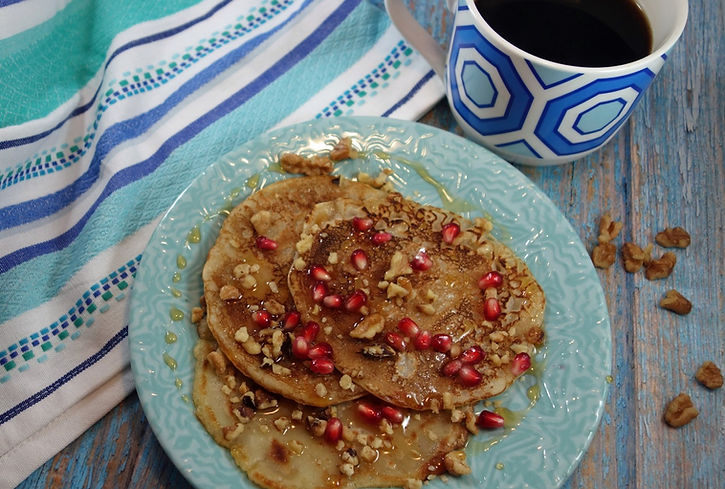
The Greekish Life
Eat and Drink
Ancient Greek Pancakes
Teganitai/Tiganites

The ancient Greeks may well have invented pancakes. At least they seem to have been the first to document the making of them.
Galen, in his "On the Properties of Foodstuffs" goes to great lengths to describe a type of griddle-cake called "teganitai", from which we get our modern Greek version "tiganites" (tηγανίτες). A frying pan is called a "tigani" (tηγάνι), so you can see from the word that this is something made in a frying pan.
Breakfast was apparently so important to the ancient Greeks that the Spartan general Clearchus made this ultimatum to the Persian messengers of King Cyrus who approached him for a possible truce: “Report to him, then, that we must have a battle first; for we have had no breakfast, and there is no man alive who will dare to talk to Greeks about a truce unless he provides them with a breakfast.” (Xenophon, Anabasis, Carleton L. Brownson, Ed.)
Breakfast, clearly, was not a matter to be trifled with. The Persians would likely not have enjoyed being on the business end of a peckish Spartan.
The good news is you can enjoy these ancient breakfast delights yourself, as they are incredibly easy to make, and only have 5 ingredients - all of which you likely already have in your kitchen. You can top them with nuts, honey, seeds or fruit.
Some recipes call for dry yeast, milk or eggs. I'm keeping it simpler. These will be slightly more crepe-like than the fluffy pancakes you may be used to, but they are every bit as delicious.
Honey will take the place of maple syrup for these pancakes. If you can use Greek honey, go for that! You can find wonderful Greek honeys online or, if you're lucky enough to live near one, Greek import markets.
On pastries
Now might be the time to speak of the other sweetmeats that they make from wheaten flour. What are called girdle-cakes [tagenitai] by the Athenians but griddle-cakes [teganitai] by us, the Asiatic Greeks, are prepared with olive oil alone. The oil is placed in a frying pan that is put on a smokeless fire, and when it has become hot the wheaten flour, soaked in a large amount of water, is poured into it. When cooked in the oil, it rapidly sets and thickens, resembling soft cheese solidifying in the wicker baskets. At this point those making it turn it to bring the upper surface underneath, in contact with the pan, bringing what was previously underneath, in contact with the pan, bringing what was previously underneath, which has been sufficiently cooked, to the top; when the underpart is now set, they turn it again, perhaps two or three times, unitl it seems to them that the whole has been cooked evenly.
It is obvious that this has thick juice, restrains the stomach and gives rise to crude humours. This is why some mix honey with it, and there are those wh also mix in sea salt. This, then, would be a class (or species, or however you want to refer to it) of flat-cake, just as country folk and very poor town-dwellers make many other such flat-cakes from whatever is to hand. For that reason those unleavened sweetmeats which they bake in a kribanos and immediately remove and put into warm honey, so that they are saturated with it, are also a type of flat-cake; and so too are all such items made with honey.
~ Galen, On the Properties of Foodstuffs
Translation by O. Powell

Tiganites/Teganitai
Ancient Greek Pancakes
(serves 2-3)
1 cup flour
1 cup water
2 tablespoons of honey for the batter, plus extra for topping (you can warm it a bit if you want to make it easier to drizzle)
a pinch of salt
olive oil for the pan
Optional toppings - sesame seeds, chopped walnuts, pistachio nuts, fresh berries, pomegranate seeds. I have even heard of topping them with grated cheese or crumbled feta for a savory option.
1. Mix the flour, water, salt and honey in a bowl until it's a smooth, lump-free batter. It should pour easily and will likely be a little more watery than the pancake batter you're used to. If you feel it's too watery, add a bit more flour.
2. Heat a few teaspoons of olive oil in a medium pan and spread it around. Make sure it's hot but not smoking.
3. Carefully pour some of the batter into the hot pan over medium-high heat, and let cook for about 3-5 minutes. Flip it over when the edges begin to turn golden brown. Flip it again as many times as needed until it's cooked through and the edges are slightly crisp. You'll need to flip it more than you would a regular pancake, or else it will be undercooked in the middle.

4. Continue in batches until batter is used up.
5. Drizzle with honey to taste and whatever else you would like.
Καλή όρεξη! Enjoy!

Add honey, walnuts and pomegranate seeds (above) or honey and sesame seeds (below)

Like this recipe?
Please Share it on Facebook and
pin it on Pinterest!
Comment below!

